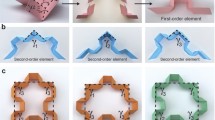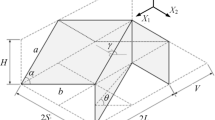Abstract
In this paper, we investigated the dynamic properties of origami structures composed of Miura unit cells with rigid facets and elastic hinges under three types of excitations: harmonic force, harmonic displacement and impact. Under the simple harmonic force or displacement excitations, different crease stiffness affects the vibration responses of Miura folded metamaterials. The single degree-of-freedom (DOF) models have one resonant peak, after which the vibration amplitude at the response end is lower than that of the excitation end. Increasing the crease stiffness can increase the resonant frequency. The multi-DOF model exhibits multiple resonant peaks under harmonic excitations, where the lowest resonant frequency has the highest peak. Increasing the number of layers can reduce the resonant frequency. When the multi-DOF model is subjected to impact load, the magnitude of the impact wave decays quickly after the impact and finally reaches a steady state with a low average strain magnitude. When the crease stiffness is increased, the propagation of the impact wave becomes faster, whereas the maximum strain magnitude becomes smaller. Introducing different damping coefficient to the crease has no influence on the propagation speed of the impact waves, but can accelerate the decay in the magnitude of the impact wave.










Similar content being viewed by others
References
Pydah A, Batra RC (2017) Crush dynamics and transient deformations of elastic-plastic miura-ori core sandwich plates. Thin Wall Struct 115:311–322
Zhou X, Wang H, You Z (2014) Mechanical properties of miura-based folded cores under quasi-static loads. Thin Wall Struct 82:296–310
Schenk M, Guest SD, Mcshane GJ (2014) Novel stacked folded cores for blast-resistant sandwich beams. Int J Solids Struct 51(25–26):4196–4214
Liu S, Lu G, Chen Y, Leong YW (2015) Deformation of the miura-ori patterned sheet. Int J Mech Sci 99:130–142
Fang H, Li S, Ji H, Wang KW (2017) Dynamics of a bistable miura-origami structure. Phys Rev E 95(5–1):052211
Sadeghi S, Li S (2017) Harnessing the quasi-zero stiffness from fluidic origami for low frequency vibration isolation. In: ASME 2017 conference on smart materials, adaptive structures and intelligent systems, pp V002T03A008
Yasuda H, Lee M, Yang J (2016) Tunable wave dynamics in origami-based mechanical metamaterials. In: ASME 2016 international design engineering technical conferences and computers and information in engineering conference, pp V05BT07A012
Yasuda H, Chong C, Charalampidis EG, Kevrekidis PG, Yang J (2015) Formation of rarefaction waves in origami-based metamaterials. Biomedical image understanding, methods and applications. Wiley, Amsterdam
Acknowledgement
The financial supports from the National Science Foundation of China (No. 11602147) and the Shanghai Aerospace Science and Technology Innovation Fund (SAST) are gratefully acknowledged.
Author information
Authors and Affiliations
Corresponding author
Rights and permissions
About this article
Cite this article
Zhang, D., Ji, B. & Zhou, X. A numerical study of the dynamic properties of Miura folded metamaterials. AS 2, 125–135 (2019). https://doi.org/10.1007/s42401-018-00023-5
Received:
Revised:
Accepted:
Published:
Issue Date:
DOI: https://doi.org/10.1007/s42401-018-00023-5




